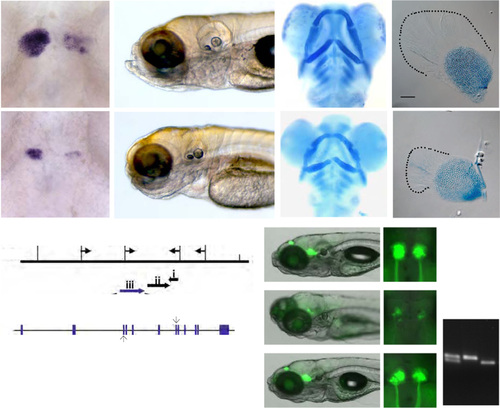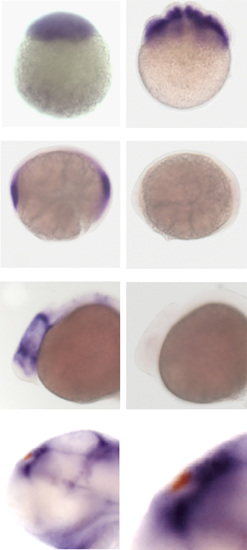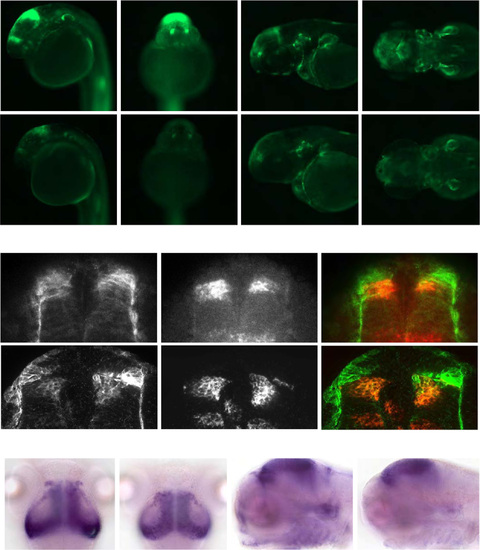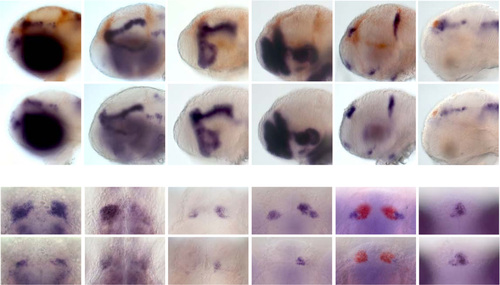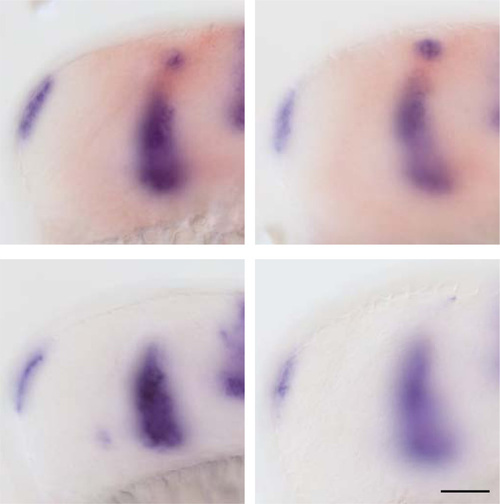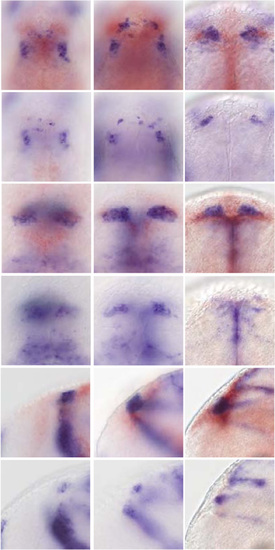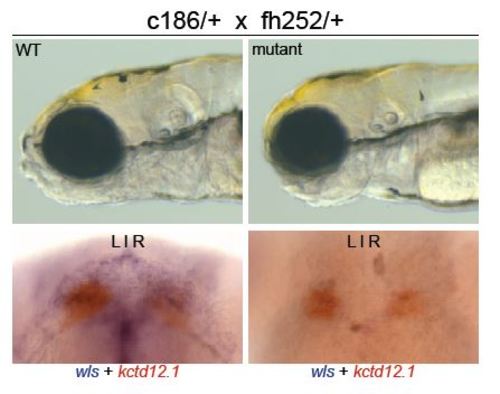- Title
-
Distinct requirements for Wntless in habenular development
- Authors
- Kuan, Y.S., Roberson, S., Akitake, C.M., Fortuno, L., Gamse, J., Moens, C., Halpern, M.E.
- Source
- Full text @ Dev. Biol.
|
Isolation of mutant zebrafish wls alleles. (A–D) WT and (E–H) c186 homozygous mutants. (A, E) The c186 mutation was isolated through an RNA in situ hybridization screen using the asymmetrically expressed kctd12.1 gene. Dorsal views, 4 dpf. (B, F) Bright field images at 6 dpf. (C, G) Alcian blue staining of jaw cartilages and (D, H) pectoral fins at 6 dpf. (I) Genetic map of the chromosome 2 region where the two ENU induced lesions are located. The c186 allele is flanked by microsatellite markers z13620 and z60815 (recombination frequencies indicated by numbers in parentheses). Three genes were annotated in this interval: gadd45aa (i); gng12 (ii) and wls/gpr177 (iii). Nonsense mutations in the fh252 (C to T) and c186 (G to A) alleles reside in exons 3 and 7, respectively. (J–M) Rescue of mutant phenotypes by injection of wls mRNA. Lateral views of WT (J), homozygous c186 mutant (K) and rescued c186 mutant (L) TgBAC(gng8:Eco.NfsB-2A-CAAX-GFP) larvae at 7 dpf. The transgene labels habenular neurons and their axons with membrane-tagged GFP. (J′–L′) are dorsal views of the dorsal habenular nuclei. (M) Genotyping of larvae was used to confirm mutant rescue (refer to Section 4 for details). |
|
wls is maternally deposited and not expressed in the dorsal habenular nuclei. Maternally derived wls transcripts are detected at the (A) 1-cell and (B) 8-cell stage. All embryos derived from heterozygous (wlsc186/+) parents have wls transcripts; however, by (C) 90% epiboly, they are no longer detected in 25% of the progeny. (D) Expression of wls in the diencephalon and midbrain–hindbrain boundary at 24 hpf is not observed in homozygous wls mutants. (E) wls transcripts (blue) are found in cells surrounding but not within the dorsal habenular nuclei (red, indicated by arrowhead in boxed area shown on right). (For interpretation of the references to color in this figure legend, the reader is referred to the web version of this article.) PHENOTYPE:
|
|
Wnt signaling is reduced in wls mutants. (A–H) The c186 mutation was introduced into a transgenic reporter of canonical Wnt signaling, Tg(7xTCF-Xla.Siam:GFP)ia4 (Moro et al., 2012). At 30 hpf, (A,B) WT siblings show robust GFP labeling in the dorsal diencephalon, midbrain–hindbrain boundary and otic vesicles compared to (E,F) c186 mutants (A, E lateral views, B, F frontal views). By 60 hpf, GFP labeling is also found in the pectoral fins and jaw of (C, D) WT embryos and is reduced in (G,H) c186 mutants (C, G lateral views, D, H dorsal views). (I,J) GFP labeling from Tg(7xTCF-Xla.Siam:GFP)ia4 colocalizes with dbx1b expression in the presumptive habenulae at 27 hpf (single section) and 35 hpf (maximum projection of 15 sections at 0.3 µm) (K,M) WT and (L,N) c186 mutant embryos were assayed for expression of the Wnt-responsive genes (K,L) lef1 and (M,N) axin2. Bilateral lef1 expression domains in the dorsal diencephalon (arrows in K) are absent in wls mutants at 4 dpf, as are axin2 transcripts in a similar region of the brain (arrow in M). Expression of axin2 is also reduced in the developing jaw and otic vesicles of (N) wls mutants. (K,L dorsal, M,N lateral views). Scale bar=100 µm for A–H and K–N and 50 µm for I,J. |
|
Defects in brain patterning confined to dorsal diencephalon. (A) Spatially restricted patterns of gene expression in the brains of WT and wls mutant larvae at 48 hpf. WT larvae are distinguished from homozygous wls mutants by the presence of wls transcripts (red), with the exception of kctd12.1 (red) and neurog1 double-labeling, where they are distinguished by dorsal habenular size. The neurog1 expression domain adjacent to the habenulae (arrowhead in WT) is reduced in wls mutants. (B) Gene expression in the habenular region. The dorsal habenulae of wls mutants show reduced f-spondin and ano2 expression but, despite their smaller size, L–R asymmetric gene expression (nrp1, kctd12.2, vachtb) is maintained (right dorsal nucleus indicated by arrow for vachtb). Expression of vachtb and aoc1 in the ventral habenulae (arrowheads in WT) is largely absent in wls mutants. The parapineal is positioned to the left of the pineal analage, as determined by otx5 expression, in WT and wls mutant siblings. Scale bars=100 µm. (For interpretation of the references to color in this figure legend, the reader is referred to the web version of this article.) |
|
dbx1b+ expression in the developing habenulae is delayed in wls mutants. Lateral view of dbx1b transcripts in the dorsal diencephalon of (A–A′) 23 hpf and (B–B′) 26 hpf WT and c186 embryos. At these early stages, wls expression (red) distinguishes WT siblings from homozygous mutants. Scale bar=50 µm. (For interpretation of the references to color in this figure legend, the reader is referred to the web version of this article.) EXPRESSION / LABELING:
PHENOTYPE:
|
|
Habenular precursor populations are reduced in wls mutants. (A–C′) Dorsal views of cxcr4b expression in the diencephalon of WT and wls homozygous mutant embryos. Dorsal (E–G′) and lateral (H–J′) views of dbx1b expression in WT and wls mutant embryos. wls transcripts (red) were used to distinguish WT siblings from homozygous mutants. Scale bar=100 µm. (For interpretation of the references to color in this figure legend, the reader is referred to the web version of this article.) |
|
c186 and fh252 alleles fail to complement. Transheterozygous (c186/fh252) wls mutants can be readily distinguished from WT larvae at 4 dpf and have similar morphological and dorsal habenular phenotypes to mutants homozygous for each allele. |
Reprinted from Developmental Biology, 406(2), Kuan, Y.S., Roberson, S., Akitake, C.M., Fortuno, L., Gamse, J., Moens, C., Halpern, M.E., Distinct requirements for Wntless in habenular development, 117-28, Copyright (2015) with permission from Elsevier. Full text @ Dev. Biol.

